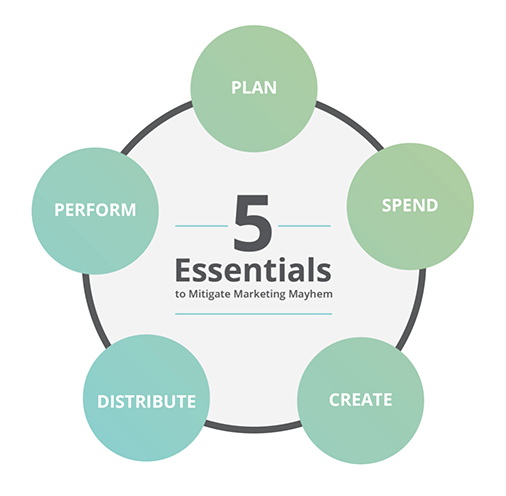Catchy taglines, sponsorships, and prime-time media buys no longer ensure market share increases, genuine engagement, or revenue growth. New technologies and communication channels have shifted the buying power from big brands to customers. Customer interest can’t simply be bought; it needs to be cultivated and presented to the right person, through the right channel, at the right moment and leave a lasting impact.
Because of this, marketing departments must function and operate in a very different way. To succeed, they must operate with processes more like lean startups and less like functional silos. Taking an agile approach to marketing requires leaders, processes, and communications to be transparent, interactive, iterative, responsive, real-time.
“There’s no question that agility IS a catalyst that allows more innovation to come from more people across a team.”
Five Key Features For Agile Marketing Operations
Marketers are pressed to prove ROI, to unify a customer journey across dozens of platforms, and to deliver customer experiences that engage and delight every time. Articulating the real, bottom line impact of marketing has challenged marketers for years. Only by taking a holistic approach that spans the five essentials of marketing (i.e. plan, spend, create, distribute, and perform) can marketers overcome the mayhem and generate measurable business results.

Plan
Organization of your marketing calendar and alignment across disciplines is the foundation of building an agile marketing team. Understanding the distribution of responsibilities — and the actual workload — is the first step to controlling the marketing mayhem. Organization of assets is imperative. Keep all assets in one place and make them easily accessible. Planning and organization will allow your team time to react and find real-time opportunities to engage customers. Marketers must understand the customer experience and cannot do so with their head in a computer screen and in planning meetings all day.
“Marketers set themselves up for success when they integrate their agile practices with more traditional research, planning, and strategy practices.”
Roland Smart, Key to agile marketing success? Integrating traditional practices
Spend
Marketers are bombarded with new services, trade shows, sponsorship opportunities, innovative ideas to drive growth, and new technology on a daily basis. It’s absolutely essential that every marketing activity ties back to the strategic plan and targets the right consumer, in a channel in which they are willing to engage.
“Precision is not reality” – Henri Matisse
Protect your marketing budget by asking a few questions, like:
- How is this going to contribute to our bottom line growth?
- Is this in line with our marketing strategy?
- Can we measure the effectiveness of this spend?
- Specifically, how will we measure the ROI?
Create
You can’t accumulate data on projects that aren’t shipped. Having a results-driven mentality means cutting the b.s., no more pointing fingers, and shipping constantly. Distribute responsibilities and assign product owners. Marketing cannot rely solely on great creative and convincing marketing jargon to win over consumers or the CEO. Content must be created for individual channels and personalized. It’s also worth mentioning organization is essential to avoid overwhelm and, when you feel like the walls are closing in due to stress, take a break.
Distribute
It’s more important than ever to cut through the noise and adapt quickly to what is working and what is not. By developing a test-and-learn culture you can rapidly test out marketing ideas and iterate based on results. Adaptability to the customer’s preference is vital to best engaging your target market. Additionally, a single consumer view is essential. You cannot track what you cannot see. Connected technology is a key component of running an agile marketing team.
“Marketing agility requires a clean, comprehensive, integrated dataset, in real time. Marketers should be selecting tools based on data portability—how easy is it to get data out of those point-tools and into your marketing data hub?”
Jennifer Zeszut, Agile Marketing And The MarTech Stack: The Tools That Can Unlock Insight And Growth
Perform
Accountability is a key differentiator between the marketing departments of today and those of the past. Ditch your “arts and crafts department” reputation by providing scientific, accountable, and data-driven results. Marketers must have a real-time feedback loop with a unified customer view in order to understand the true value of a conversion and track the entire customer journey.
Implementing the five essentials that we have shared today will help you mitigate the Marketing Mayhem, change the conversation, and take back control of your marketing operations. The good news is that everyone out there is susceptible to Mayhem. So, if you master the five essentials, not only will you get your own marketing house in order, but you will also have the potential to create Mayhem for your competitors.
Are you ready to perform smarter marketing in 2017? Or, are you still struggling with challenges such as increased budget scrutiny, ineffective channel strategies, and out-of-date asset management systems?
How does your marketing agility compare with your peers?
Take the Managing Marketing Operations Mayhem Survey now!
Photo credit: Flickr